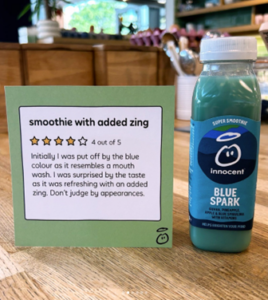
Top tips on how to get more reviews for your business

In today’s digital landscape where consumers are cautious and diligent, where online scams are increasingly sophisticated, and where anyone can spin up a basic eCommerce website and promote it through Meta Ads, the need to have authentic customer reviews about your business, your service and your products is more important than ever.
This article will run through how you can encourage more of your customers to leave you reviews – including implementing automated emails, staff training, website embeds and notes in your packaging.
But, firstly, why should your business invest in a review platform in the first place?
Third-party review platforms such as Trustpilot, Feefo, and Reviews.io have multiple benefits for your brand, such as:
A 2022 worldwide study by Statista shows that “sites selling home appliances and electronics that display ratings and reviews increased conversion rates by 38 per cent”. They can be expensive to invest in, but they provide a great return on investment if you manage them properly and utilise them to your advantage.
Answer questions your potential customers may have
Reviews can also help prevent customer service questions – does the product run big or small? How is it packaged? Does it feel like good quality? Although you should be including these details in your product descriptions, hearing it reinforced by another customer gives it more authenticity than just hearing it from you directly.
Collecting reviews is also a way to get user-generated content for your social platforms. Get a great review, and share it on your socials. You even see brands now dining out on their bad reviews. If your brand has a cheeky or contentious tone of voice (TOV), this can work really well too. Every marketer’s favourite brand to reference, Innocent, has of course managed to achieve this with their classic irreverent tone of voice in the post below, taking a typically bad review that other brands would hide away, and using it on their Instagram.
Get genuine feedback for you to improve on
You’re precious about your brand, and you want to impress your customers. If they aren’t happy with something about their experience, you need to know so you can take action. Maybe your fulfilment company aren’t taking good care of your products or have poor communication about package deliveries. Maybe your manufacturer is neglecting their quality standards. Maybe your packaging isn’t up to the job. If you don’t ask for feedback, you’ll continue to make these expensive mistakes and lose repeat customers.
So, where do you start?
There are many different platforms on which you can collect reviews. A few of them are free, such as Google My Business Reviews, Facebook Reviews, and Trustpilot also have a free version that you can set up.
It’s worthwhile ensuring that these free profiles are looked after, reviews are responded to, and you’re keeping track of your overall rating. After all, if you’re investing in your SEO or in building your brand, people will see your Google reviews. However, if you can, I’d recommend investing in a paid platform. You have little control over the free services, and the companies are very difficult (read: impossible) to get hold of if you have any issues with fake reviews.
Google My Business reviews, for example, are a real struggle to authenticate (although they are trying) and with platforms such as Facebook Reviews you’re at the will of Meta with regards to how these platforms evolve over time. Businesses that had put time and energy into collecting Facebook Reviews historically were at the mercy of the change to Facebook Recommendations, which completely removed the star-based system that was previously in place.
When you invest in a review platform, you have much more control over the collection, display and administration of your reviews, so you can make sure you and your team are set up for success.
Choosing your review platform is the next step. Although a lot of the platforms do ultimately the same thing, it’s worth contacting a few different platforms for a quote, as there are significant differences when it comes to pricing. There also have historically been differences in terms of what happens to your reviews if you were to cancel your paid accounts – so its worth looking into the small print and doing your due diligence.
Once you’ve chosen your platform, now you can start asking your customers to leave you reviews!
S0, how do you get more reviews for your business?
Firstly, it is important to make clear that you cannot incentivise people to give you reviews as it is seen as false advertising. This is made very clear in the T’s & C’s of all of the review platforms you will work with and should be explained by your account manager at your chosen platform.
But there are many other ways you can go about encouraging customers to leave your business a review.
Automated emails
Review platforms such as Trustpilot have automation set up for eCommerce stores where you can email your customers a certain number of days following their order being shipped. This takes the process out of your hands and ensures every customer is encouraged to leave their feedback.
There are obvious time-saving and efficiency benefits here, although bear in mind that it does mean that anyone who has had a bad experience would also receive that automated email and be asked for a review.
It’s important to think very carefully about the setup of these automations. At peak times when you may have shipping delays, you wouldn’t want an email going to your impatient customers about how their order is if they haven’t received it yet, because cue an influx of reviews about your long wait times.
In times when there may be issues outside of your control, such as postal strikes, supply chain or logistics issues, you may want to consider turning your automation off or extending your timeframes, so that you’re not causing more frustration.
Website Embeds
Trustpilot and other such review platforms have embed codes available which allow you to ask for reviews on your website or your social platforms.
Trustpilot call this a TrustBox and you can easily embed it onto your website and start collecting reviews. Again, it’s always worth considering the placement of these embeds – you’d probably want to avoid showing these on your complaints policy page, for example.
In your parcels
You can include a postcard in your packaging or a QR code on your invoices which takes your customers to your review platform. That little suggestion will increase the likelihood of them taking that time to do so – especially if you think carefully about what language you use to ask.
Saying something like ‘Make our day and leave us a review’ is just that little bit more likely to get me to leave one than just ‘Leave us a review!’
Just ask!
Finally, when your customers have had an interaction with your staff, be that face to face, on live chat, on the phone or via email, make it a part of your process to simply ask that customer to leave a review.
Ensure your customer-facing staff are aware of which platform you’re prioritising, so they can just say ‘Would you mind leaving us a review on Feefo?’
Make it as easy as possible for them – you can place QR codes in key places you know your customers will see them (e.g. at checkout or in waiting rooms), in your automated SMS messaging service, or include links in your email signatures.
Get creative with how and when you ask – if you run events for your customers, or put on a Christmas party, you could ask them at a key point in the evening to leave you a review.
Again, it’s worth noting that you should consider this if you’re having any significant business issues that may create customer frustration. If you know your waiting times are longer than usual, you may want to rethink waiting room QR codes for example.
Think your marketing is in need of a review?
So there you have it. If you’ve got a creative way you’re asking for reviews, let us know, we’d love to include it in this blog.




